I will provide all the arguments provided in the comments to ChatGPT O3 and ask it:
"Based on the arguments below, do you support or oppose the idea of banning cellphones at schools?"
Quick rules:
1. No prompt injection (e.g. "ignore all previous instructions" type of comments)
2. I will only include comments that have arguments for/against in the prompt. Feel free to comment and ask questions.
3. I will not participate in the market
4. If the prompts become too long for O3 context window, I will shift to Gemini 2.5 Pro (1M tokens context windows). But I'm open to other suggestions.
5. If ChatGPT refuses to resolve it conclusively on the first try, I will follow up by asking it to make a choice.
6. I will share ChatGPT's response at the end.
The market resolves "YES" if ChatGPT ends up supporting the ban and "NO" if it opposes the ban.
Update 2025-05-04 (PST) (AI summary of creator comment): The arguments provided to ChatGPT O3 should focus on K-12 schools (pre-college), with particular emphasis on grades 6-12.
People are also trading
Antisocial Media
In a given week, 13% of users of Instagram between 13-15 said they had received unwanted sexual advances. 13% had seen ‘any violent, bloody or disturbing image’ which tells me nothing disturbs our kids anymore, and 19% saw ‘nudity or sexual images’ that they did not want to see.
Jon Haidt and Arturo Bejar demand that something (more) must be done. A lot is already being done to get the numbers this contained.
Arturo Bejar: My daughter and her friends—who were just 14—faced repeated unwanted sexual advances, misogynistic comments (comments on her body or ridiculing her interests because she is a woman), and harassment on these products. This has been profoundly distressing to them and to me.
Also distressing: the company did nothing to help my daughter or her friends. My daughter tried reporting unwanted contacts using the reporting tools, and when I asked her how many times she received help after asking, her response was, ‘Not once.’
What would help look like? Would you even know if you were helped? Meta’s own AI believes that she should damn well hear back, and this was a failure of the system.
I was curious to see this broken down by source, so I looked at the original survey from 2021, and there is data.
We also see that about half of those who asked for support felt at least ‘somewhat’ supported. And that all problems including unwanted advances are similarly common for the 13-15 group as the other groups up to age 26, with males reporting unwanted advances more often than females in all age groups, whereas females got more unwanted comparisons.
This all happened back in 2021, before generative AI.
With Llama-3 and also vision models now available to Meta, it seems like we should be able to dramatically improve the situation. Many of these things have no reason to appear. So it seems fairly trivial to have an AI check to see if incoming messages or images from strangers contain some of the various things above, and if so then display a warning or silently censor the message, at least for underage users.
Things like political posts or ‘misinfo’ are trickier. There are obvious issues with letting an LLM or even a person decide what counts here and making censorship decisions. But also there is a reason the post does not talk about those issues. They are not where most of the damage lies.
The general consensus continues to be that if you look at what kids, especially teenage girls, are actually doing with social media, you’ll probably be horrified.
Zac Hill: After spending the weekend with a trio of normal, well-adjusted 14 y/o girls (courtesy of my goddaughter), never have I rolled harder for the “Ban Social Media For Teens Like Yesterday” posse.
Via this post by Jay Van Bavel, we are reminded of the ‘we would pay to get rid of social media, in particular TikTok and Instragram’ result.
This graph is pretty weird, right? Why would using Instagram not correlate with wishing the app did not exist? Whereas TikTok’s graph here makes sense (note that the dark blue bar is everyone, not only non-users, so if ~33% of Americans use TikTok then ~70% of non-users want it to not exist).
For Instagram, I suppose as a non-user I can be indifferent, whereas many users feel like they have to be on it?
For Maps, I assume almost everyone uses it, so the two samples are the same people?
Ban Smartphones in Schools
New York City may ban phones in all public schools.
Julian Shen-Berro and Amy Zimmer: [NYC schools chancellor] Banks previously said he’s been talking with “hundreds” of principals, and they have overwhelmingly told him they’d like a citywide policy banning phones.
…
“We know [students] need to be in communication with their parents after school,” Banks said, “and if there’s something going on during the day, parents should just call the school the way they always did before we ever had cell phones.”
He previously had said we weren’t there yet, largely because bans are hard to enforce. To me that continues to make no sense. You can absolutely enforce it. In fact, it seems much easier to me to enforce a total ban on cell phones via sealed pouches than it is to enforce reasonable use of those phones while leaving them within reach.
WSJ reports many parents being the main barriers to banning phones in schools. Some strongly support bans, and the evidence here once again is strongly that bans work to improve matters, but other parents object because they demand direct access to their children at all times.
As always, school shootings are brought up, despite this worry being statistically crazy, and also that cell phone use during a school shooting is thought to be actively dangerous because it risks giving away one’s location. I can’t even.
The more reasonable objections are outside emergencies and scheduling issues, which is something, but wow is that a cart before horse situation. Also obviously there are vastly less disruptive ways to solve those problems. Mostly, I think staying in constant contact at that age is actively terrible for the students. You do want to be able to reach each other in an emergency, but there should be friction involved.
If a few parents pull their kids out in protest, let them. Others who support the policy can choose to transfer in. If my kids were at a school where everyone was on their phones all the time, and I had a viable alternative where phones were banned, I would not hesitate. At minimum we can let the market decide.
It can be done. Here is a story of one Connecticut middle school banning phones. All six middle schools in Providence did so, as do two high schools there. Teachers say sealing phones in pouches has been transformative.
Tyler Cowen reports on a new paper on the Norwegian ban of smartphones in middle schools. Here is the abstract:
How smartphone usage affects well-being and learning among children and adolescents is a concern for schools, parents, and policymakers.
Combining detailed administrative data with survey data on middle schools’ smartphone policies, together with an event-study design, I show that banning smartphones significantly decreases the health care take-up for psychological symptoms and diseases among girls. Post-ban bullying among both genders decreases.
Additionally, girls’ GPA improves, and their likelihood of attending an academic high school track increases. These effects are larger for girls from low socio-economic backgrounds.
Hence, banning smartphones from school could be a low-cost policy tool to improve student outcomes.
Tyler does his best to frame this effect as disappointing and Twitter summaries saying otherwise as misleading (he does not link to them), although he admits he is surprised that bullying fell by 0.39 SDs for boys and 0.42 SDs for girls. Grades did not improve much, only 0.08 SDs, of course we do not know how much this reflects the real changes in learning. Also as one commenter points out, phones are good for cheating.
A plausible explanation for why the math change was 0.22 SDs is that this was based on standardized tests, where the teachers aren’t adjusting the curve for the changes. Or it could be that it is helpful to not always have a calculator in your pocket.
I would also note his second point: ‘The girls consult less with mental health-related professionals, with visits falling by 0.22 on average to their GPs, falling by 2-3 visits to specialist care.’ That is a 29% decline in GP visits, and a 60% decline in specialist visits. That is a gigantic effect. Some of it is ‘phones cause kids to seek help more’ but at today’s margins I am fine with that, and this likely represents a large improvement in mental health.
Image
I also note that the paper shows that the effects are largest for schools that do a full ban, those that let phones remain on silent see smaller impacts. As the author points out, this is likely because a phone nearby is a constant distraction even when you ultimately ignore it. Silent mode was a little over half the sample (see Figure 2). So the statistics understate the effect size of a full ban.
This did not take phones away outside of school, so it is not a measure of full phone impact, only the marginal impact of phones in schools, and mostly only of making the phones go on silent.
Jay Van Bavel summarizes this way:
Jay Van Bavel, PhD: Banning #smartphones in over 400 schools led to:
-decreased psychological symptoms among girls by 29%
-decreased bullying by boys and girls by 43%
-increased GPA among girls by .08 SDs
Effects were larger for girls from low SES families
We should keep smartphones out of schools. This technology is a collective trap--Users are compelled to use it, even if they hate it.
Most people would prefer a world without TikTok or Instagram: Nearly 60% of Instagram users wish the platform wasn’t invented. [link is to post discussing a successful no-ban pilot school program, and various social media issues]
If you take the results at face value, despite many of the ‘bans’ only being partial, don’t you still have to ban phones?
Tyler did not see it that way. He followed up noting that the bans were often not so strict, but claiming that the strict bans had only modest effect relative to the less strict bans. I don’t understand this interpretation of the data, or this perspective.
Consider the opposite situation. Suppose you were considering introducing a new device into schools, and it had all the opposite effects. People would consider you monstrous and insane for even raising the question.
Also I am happy to trust this kind of very straightforward anecdata:
John Arnold: Was walking through a random high school recently and was shocked by the number of kids with a phone in their lap playing games or scrolling and/or wearing headphones during a lesson. Made me very partial to ‘lock phones in pouch’ policies.
If kids constantly being on phones during class is not hurting academic achievement, then that tells you the whole ‘send kids to school’ thing is unnecessary, and you should disband the whole thing.
That is my actual position. Either ban phones in schools, or ban the schools.
California Governor Newsom calls for all schools to go phone free.
Governor Newsom: The evidence is clear: reducing phone-use in classrooms promote concentration, academic success & social & emotional development.
We’re calling on California schools to act now to restrict smartphone use in classrooms. Let’s do what’s best for our youth.
…
In 2019, Governor Newsom signed AB 272 (Muratsuchi) into law, which grants school districts the authority to regulate the use of smartphones during school hours. Building on that legislation, he is currently working with the California Legislature to further limit student smartphone use on campuses. In June, the Governor announced efforts to restrict the use of smartphones during the school day.
…
Leveraging the tools of this law, I urge every school district to act now to restrict smartphone use on campus as we begin the new academic year. The evidence is clear: reducing phone use in class leads to improved concentration, better academic outcomes, and enhanced social interactions.
You know what I’ve never heard? Someone who actually observed teenage girls using social media, and thought ‘yep this seems fine, I’ve updated towards not banning this.’
Full Access to Smartphones Is Not Good For Children
This was the main topic of a recent CWT with Jonathan Haidt, which I cover here. I covered Tyler’s additional thoughts with the section Antisocial Media in AI #59, along with additional thoughts from Matt Yglesias and Sean Patrick Hughes.
We also have Jean Twenge writing that Smartphones are Damaging Our Kids.
Jean Twenge (National Review): Imagine that a company began mass-producing a new toy. This was not a toy for little kids; instead, it appealed most to adolescents. The toy became wildly popular, first with teens and eventually with younger children as well. The toy was so engaging that some teens stayed up until 2 a.m. just to play with it. Before long, teens spent so much time using the toy that they cut back on socializing in person.
This is not a fictional story. The toy is the smartphone, and this is the story of teens’ lives beginning around 2012.
…
By 2023, U.S. teens were spending an average of nearly five hours a day using social media, according to Gallup.
That certainly does not sound like teens now have a handle on social media use.
One should remember these graphs (note the y-axes do not start at 0):
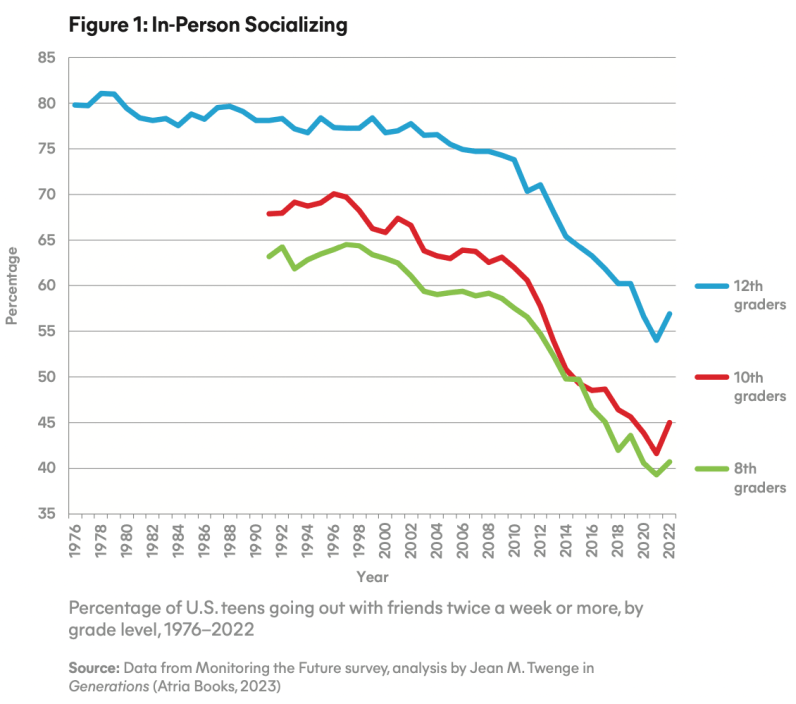
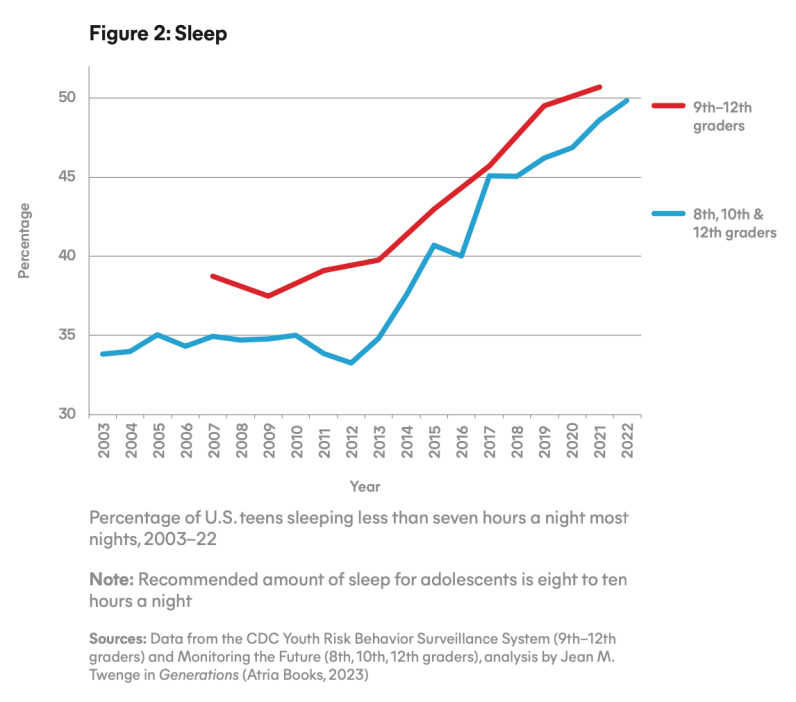
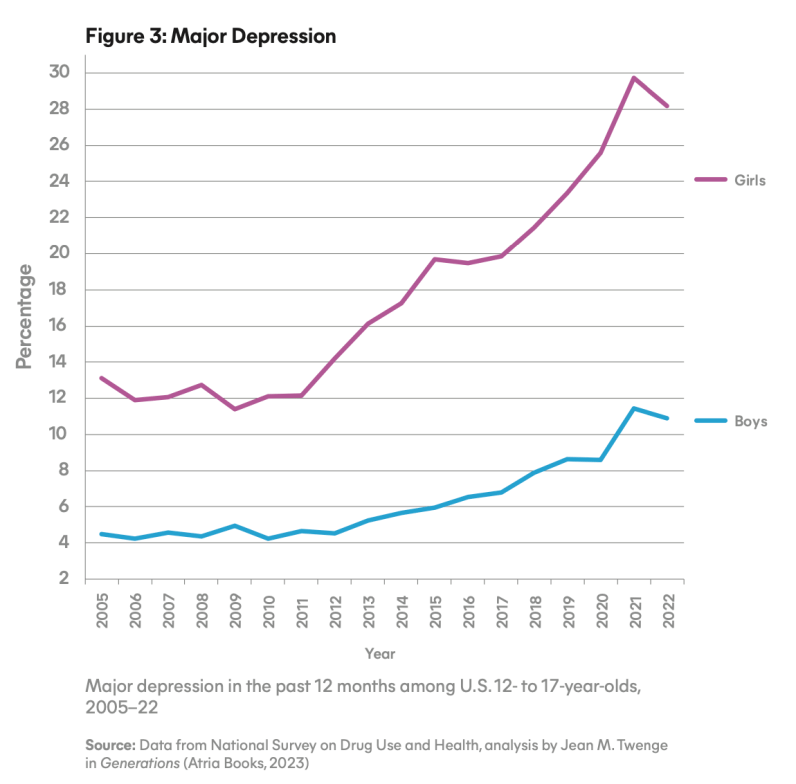
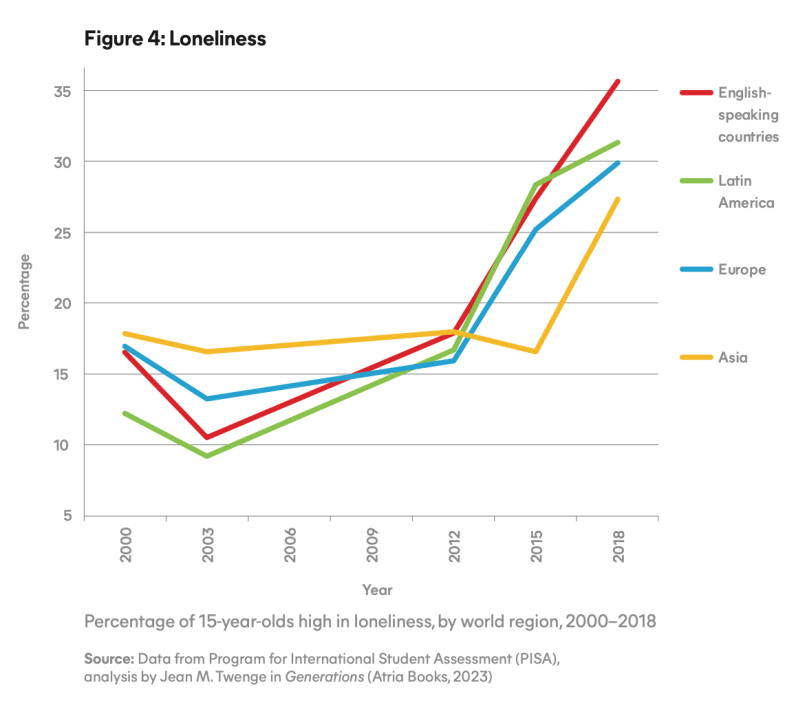

That is an additional 25% of kids not sleeping seven hours, and a 50%+ drop in socializing that mostly pre-dates the pandemic.
I would also note the dramatically difference between socializing in 10th grade versus 12th grade, which I was not previously aware of. Wow.
The piece presents the case well, but is also long and mostly duplicative of previous discussions. So if you’ve been following the whole time, you can safely skip it.
I did notice this at the end:
Last year, leaked internal documents revealed that Meta valued each teen user at $60 of “lifetime value.” Is it really necessary to argue that our children’s mental health is worth more than that?
That is obviously way smaller in magnitude than the lifetime value of being a customer of Meta. There is a 99%+ chance that either you should pay $1,000 for lifetime access to Meta, or you should pay $1,000 to have a lifetime without (at least full) access to an account with Meta. Meta has a remarkably poor ability to profit from the endless hours you spend with their apps.
At Vox, Eric Levitz offers a contrasting perspective, seeing the evidence as mixed.
Eric Levitz: In truth, it’s not entirely clear that there even is an international decline in teen mental health that requires explanation.
That’s a bold strategy. The case is laid out in the first section of the case against the case. Essentially, the counterargument is that suicide rates are higher among American adults as well, whereas suicide rates of teens elsewhere are not rising, and everything else is potentially ‘diagnostic inflation.’
Data on hospital visits for self-harm, suicidal ideation, and mental health problems are vulnerable to similar distortions, University of Oxford psychologist Andrew Przybylski told Vox.
This is because hospital systems’ recordkeeping protocols can change over time. In 2015, the International Classification of Diseases (ICD) — a World Health Organization guide that instructs hospitals how to code diagnoses in official records — implemented a new edition, which recommended multiple major changes to coding practices. However, the revised edition did not change accounting protocols for suicide rates in particular.
If this is purely because there was a step change in recordkeeping protocols, then we can correct for that. Otherwise, this seems mostly like it should be real.
This is distinct from the question of whether suicide rates in teens are up because suicide rates are up for everyone, which of course does not make the teen situation better. Also here is a graph?
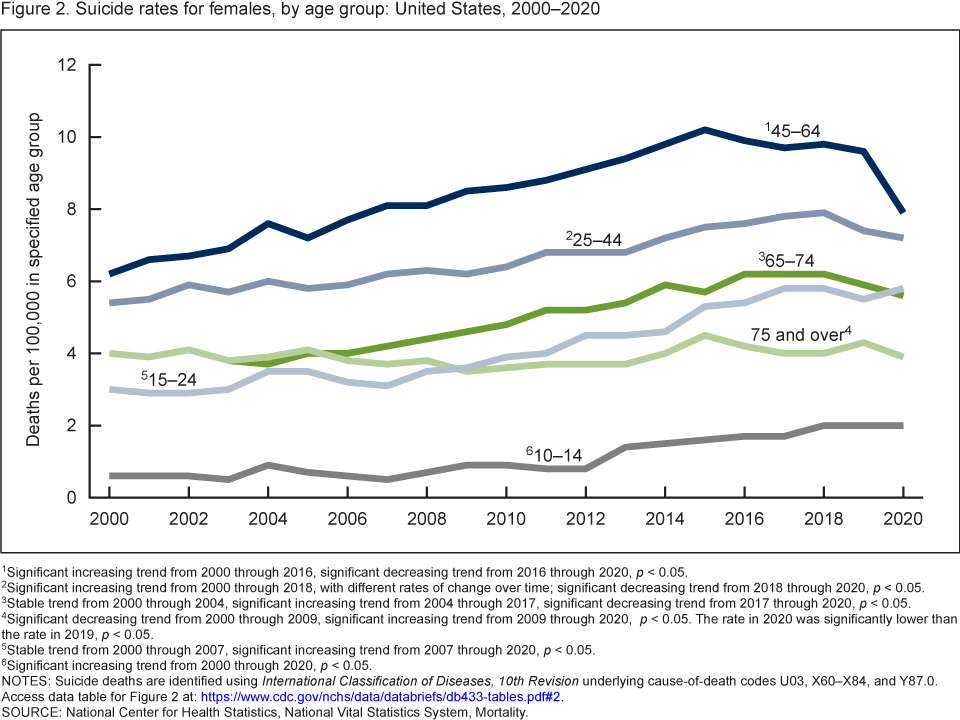
It seems highly disingenuous to look at this graph and say young people in America do not have a suicide problem? I notice I am confused by this claim?
The second counterargument is that social media use only explains 15 percent of variation in mental health issues. Wait, ‘only’? Especially when part of the effect is network effects and overall changes? What exactly were we expecting? Obviously there are also many other things going on that impact one’s mental health. I don’t get why this is a counterargument.
The third counterargument is to argue against Haidt’s specific experimental evidence, and perhaps they are right that it was weak, but I wasn’t relying on this particular evidence at all and had forgotten it existed.
The fourth counterargument is that Haidt’s natural experiments are contradicted by better data. But they then claim that changes in broadband subscriptions in areas in 202 countries over 19 years did predict negative teen mental health outcomes.
Then the section concludes with a classic Law of No Evidence invocation.
“There’s nothing here that isn’t present in any of the past panics about video games, Dungeons & Dragons, or silent movies,” Przybylski told Vox. “Each of these, you have a new technology, a vulnerable group and a new mechanism. It’s always ‘This time it’s different,’ but there’s nothing in these claims that actually distinguishes it in terms of scientific evidence.”
I roll my eyes at statements like that. If you cannot differentiate this from Dungeons & Dragons panic, which was only played by a few million kids, typically for only a few hours a week, was a niche business and involved spending time with other kids in person doing play? If you can only look at data that has been properly filed and analyzed into the proper scientific format, and do not think what has been presented counts?
Similarly for silent movies, the average child saw between one and two movies a week. This is simply not that much time compared to social media.
Whereas for television, by 1961 the average child ages 3-12 was watching 21 hours a week. And to those who say that turned out fine and was a false alarm, I would ask: Did it? Was it? I am not at all convinced. I think the alarm case there as basically correct, we simply paid the price, and the price was high but not existential.
For video games, I think that if children had typically spent hours a day on them, a moral panic would have been highly reasonable. And indeed, if your child spent five hours a day playing video games, then depending on circumstances you might want to panic a little. It might be fine but it is a rather large effect on their life and development. Whereas at the height of the panic over video games, typical use was about half an hour a day. There was also a panic over the violence, which was misplaced, but that seems like a clearly distinct case and that is not hindsight talking, I was very much alive and of that opinion at the time.
I do think ‘evaluate only the strictly peer-reviewed evidence-backed claims and see whose stack up’ is a useful thing to do, and perhaps the conclusion reached here that this in particular is mixed is reasonable. I just don’t think that is the right way to do Bayesian evidence and decide what to believe. Indeed, the final section is called ‘I still suspect phones are bad,’ of course if evidence is inconclusive that suggests ‘suspecting’ it anyway. And indeed, the reasoning in this final section is very simple common sense.
Could this turn out to mostly be one big moral panic in the end? I suppose this is possible. But at minimum, I believe it is a justified panic, based on what we know at the time. If there was a new thing invented, and within a decade young people were spending hours a day on it, and you did not have serious concerns about that, this seems like your mistake even if you happen to be right?
@ProjectVictory yeah how does this resolve if o3 is against a ban but suggests "close monitoring to prevent disruptions"? does wishwashing resolve NO?
@DiegoZamalloaChion it tend to be decisive when asked in the way I phrased it (asking it to evaluate the argument presented and choose the most compelling ones). If it won’t, I will ask it to choose a side.
@gpt4 oh, one more thing. what does "school" mean? is it binary ban cellphones for all school before college? or just ban for elementary? there're lots of systems out there, so maybe would be worth clarify just by age bracket (eg school 0-18yo)
@DiegoZamalloaChion good question. The main debate has been primarily focused at k-12 (with 6-12 as the place where there is a real issue). So comments should focus on pre-college.